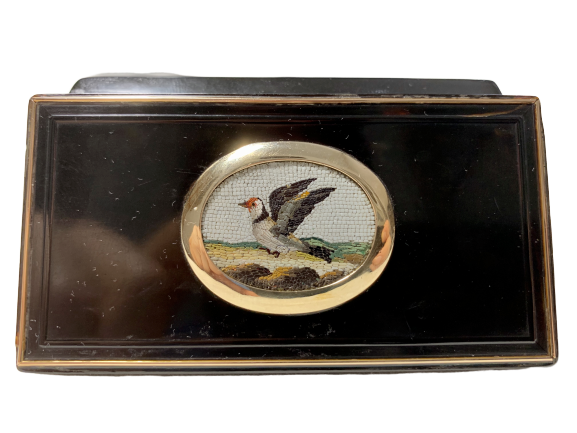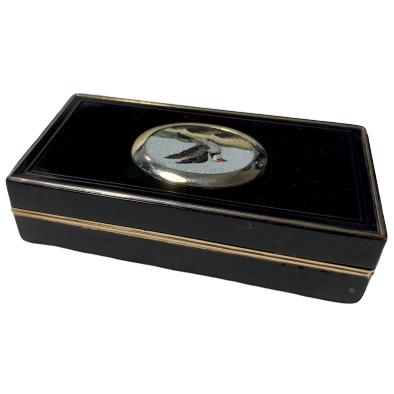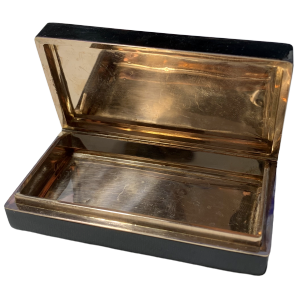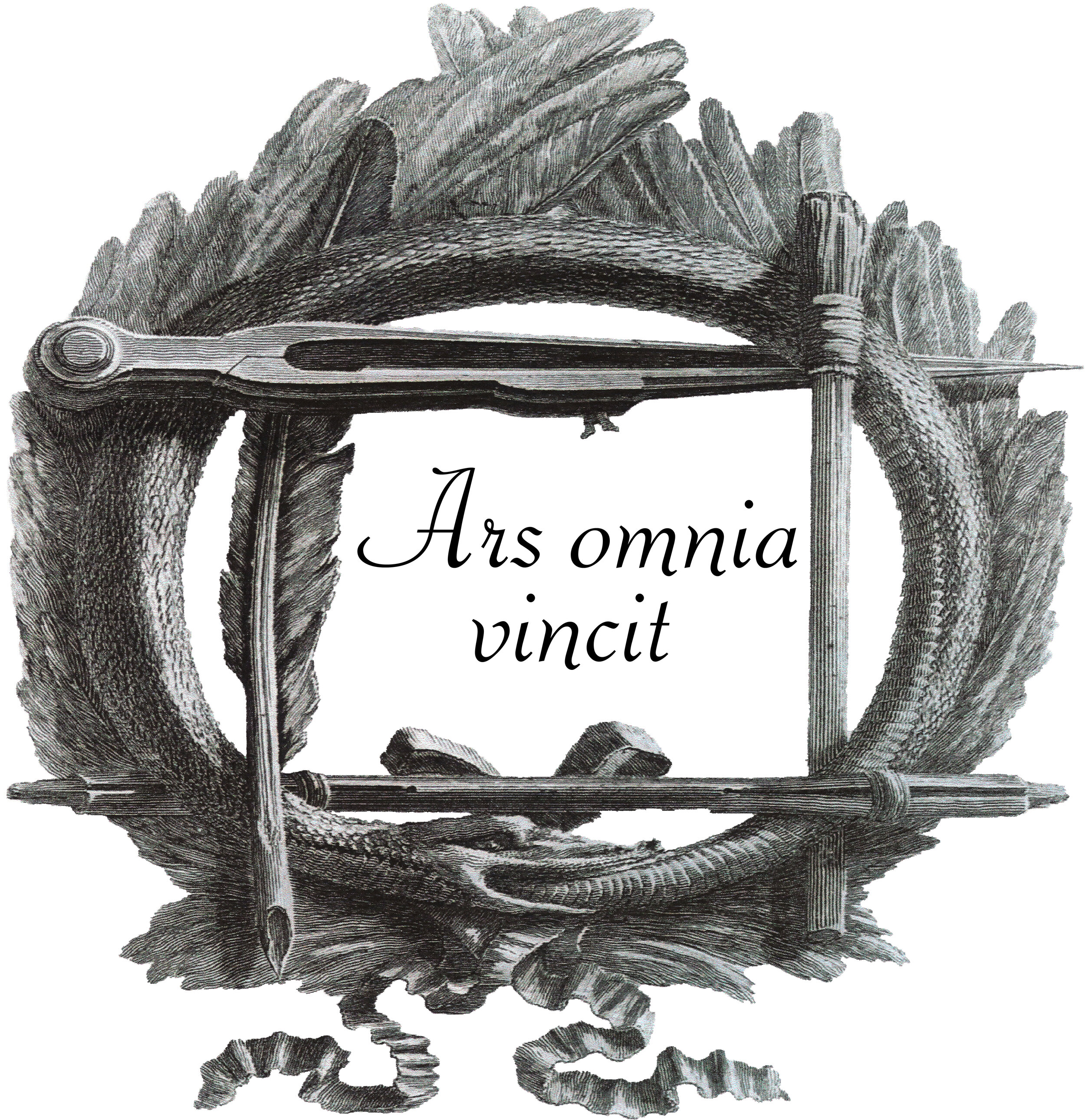Tortoiseshell snuff box with bird micromosaic





Tortoiseshell snuff box with bird micromosaic
Snuff box in tortoiseshell composition entirely lined in 18kt red gold. On the hinged cover is mounted an oval micromosaic set on copper depicting a small bird probably a goldfinch.
French making for the box and Rome for the micromosaic late 18th/early 19th cent..
Dimension cm 8.5 x 4.5 x h2.1the box - the micromosaic cm 2.7 x 2.1
Excellent condition commensurate with age.
History of Micromosaics A lost art The Rome of the 1700 had a great tradition in the field of manufacturing mosaics, consolidated in the course of two centuries. Since the second half of 1500 Pope Gregory XIII (1572-1585), the pontifical administration, through the Congregation of the Reverend Fabbrica di San Pietro, responsible for the care of the Vatican Basilica, he had done its utmost in the creation of a school of mosaic that was operating in her womb, reaching, in 1727 the institution of the Vatican mosaic Studio. In this first phase the mosaic technique was practiced exclusively that of the traditional mosaic large cut enamel, a kind thought to be admired at a distance. But in the late eighteenth century, the Roman artists began to also experience the mosaic technique in small or minute in spun glass, now known as micro mosaic. The new kind mosaic, from quard at close range, they opened the free market, lending itself to the creation of products for the person and fittings. Inside the Vatican Studio in the minute work they were introduced at a time when there was no work and mosaic workers lacked the necessary income to live. The success of the private sector of the micro-mosaic at this early stage can be traced to the following circumstances: the neoclassical culture, particularly popular from European companies linked to the phenomenon of the Grand Tour, which promotes demand for precious works inspired by the old; the drive for innovation and modernization impressed at the Vatican mosaic workshop in the period when Rome was under French rule (1809-1814); the foundation in Paris of a mosaic school which, though it lasted for a short period, has left a strong mark among the mosaic artists, accustomed to working only within the Vatican Studio. The production of specialized in micro mosaic mosaic found in development works both religious and secular. The main buyers were sovereign, high-ranking aristocrats, bourgeois wealthy but also silversmiths and goldsmiths (Roman, French, Austrian, Russian and English) asking plates to be mounted on jewelry or boxes (snuff, favors gold, silver, tortoiseshell, wood, vernis martin, lacquer, marble, etc). The most sought-after subjects by travelers on the Grand Tour, as a souvenir of their trip, they were Roman landscapes, flowers, animals, characters and scenes taken from mythology or the ancient paintings. Following the great success of the Roman mosaic, both in cut it into yarn, some mosaic masters moved, invited by the Tsar in St Petersburg where they founded a school similar to the Vatican. The experiment only lasted a few years but it was enough to leave an indelible mark, as well as the School of Paris established by the French, but directed by Roman mosaic. On the choice of themes, the micro-mosaic artist offers greater freedom of interpretation of the subject which is, however, almost always inspired by famous pictorial subjects. Raw material of the micro-mosaic is the enamel composed of fused silica mixed with minerals which allow hardening, keeping the fragility of glass. The enamel for mosaics was produced in small loaves (or pizzas), from which by means of the chisel and the hammer is ricavavno, predominantly, square-shaped tiles. The "thread" enamel is rather worked in the shape of long sticks (wands) derived from the fusion of the reduced enamel pieces. Immediately after the first trial of the yarn, the specialists of this technique is realized that it was possible to produce rods containing multiple colors in a single piece, senna that the same is amalgamassero between them. The use of this enamel in several colors, said malmischiato, led to a considerable shortening of processing times, facilitating the yield of some subjects such as animals - especially in relation to the mantle yield - and the vegetation, without however affect the quality finished work. The characteristics of the card "cut" and the "spun" are the following: - the tiles of the cut mosaics (stone or glass paste) are square and of about 1 cm per side. - The tiles of micromosaics in enamel are approximately 1mm per side. -the form of spun card is the one assigned to the wand of enamel at the time of spinning: with this preliminary operation, the artist gets tiles of each type of form, without further processing. The support within which the mosaic is made can be achieved by different materials. The choice is determined primarily by the size and destination of the mosaic decoration. The most used media, starting with the oldest (the second half of '700), are as follows: - thin copper plates, are necessary to hold the job and about 3 mm high board, the flexible and lightweight copper was the same used for carvings.- Opal glass, oval or rectangular with rounded shape of 3-4 mm thickness, such as to contain the adhesive and the tiles within the plate without compromising the necessary resistance. - Glass plates, pre-formed of various colors. This support was used to tiny mosaics suitable to be embedded and used as jewelry. - Stone holder (black Belgian marble) very compact and free of schist and easy to dig to create the fund. It is generally oval or rectangular and it was used for ink ducts, paperweight, table tops, squares of different sizes. The different types of time sometimes coexist in the support. The realization of a minute mosaic began with the fill in the support with the sealing compound and thereafter with a layer of plaster. The chalk was drawn in charcoal on the subject to be dialed. L 'execution is then held by removing, one after the other, small portions of plaster and inserting in the underlying mastic the tiles suitable to reproduce the part of the cropped design. The time of realization was bound to hardening that varied with the thickness and the size of the work to be carried out (months or years). Once the seasoning was done in a very delicate wax finish work to close the gaps and then began sanding with flint and polishing lead. The works in the micro mosaic are in any case amazing handcrafted pieces but they can also qualify as true works of art. The relative short duration of this art form makes problematic the dating of its products, for the superimposition of styles and techniques have occurred too rapidly. It should be remembered that only a fraction of these works are signed. The lack of signature must be attributed to the fact that the mosaic did not feel the work creators but simple players. In iconographic field we are witnessing the transition from static to a classic style and a careful naturalistic style to the rendering of movement. The origins of the production funds are owned by the combined color abstract preference and weaving parallel studied precision courses; the shot is frontal, the color palette pretty basic. In the early nineteenth century, with the 'advent of the new cultural climate brought by Romanticism, change the subject, shows the movement and expands the palette. This change is made possible by the introduction of irregular shaped tiles, capable of producing dynamic effects. The mosaic will not intervene more on the alignment of tiles to obtain a curved shape, but will use an already curved tile. become recurring themes, in addition to the views of the Roman monuments that will always remain the main subject, landscapes, animals, flower arrangements. In conjunction with these innovations we are witness to a remarkable expansion of the color palette and the emergence of a new painting style that manifests itself in the search for a lively contrast of colors. mosaic is not the minute news stories but always maintains a close relationship with the painting of the great masters. Its production of the Romantic period is often the result of the merger of the enforcement procedure adopting square chips than adopting irregularly shaped tiles. The fusion takes place with a careful adoption of the two forms of expression, because of the type of figurative yield which is optimal to make the different parts of the subject. In the case of the Roman landscapes, for example, the first taste typically neoclassical where the ruins, are viewed with a careful eye on the investigator, scholarly and connoisseur, be related to the style of Piranesi, happens a representation in which the ruin is entered into a bushy landscape and open to distant views of hills, in a calm and in a midday light. The atmosphere is definitely more careful to record the emotions rather than to convey the classic image, message vehicle arcane and sometimes esoteric. pictorial characteristics of these "romantic mosaics" are coloring the sky, the background of the sloping plane, the water flows, the warm coloring of the bricks and the clear distances of landscapes. A close relationship with the painting was seen by artists like Antonio Aguatti (late eighteenth century - 1846), a great master of micromosaico who accordiato the distances between mosaic and painting by adopting the necessary techniques and expanding the color palette. After half of the 800 production of micro mosaic reflects the historical events that have undermined the productive world of all countries of the old continent and the emergence of industrial civilization. In this new reality the mosaic is located n she position of having to increase production and reduce costs. The main solutions adopted to accelerate the production were two: the widespread use of the malmischiato enamel and that, as has already been said, the yarn glazes containing more colors in a same wand, and the use of preformed elements for the realization of some parts of the composition, in particular of the architectural elements (lintels, pillars, windows ; and vegetation. in general, then, is resorted adoption of larger tesserae and to a less tightened their disposal. the interstices too wide between a tile and 'other were then hidden, to complete the composition, with the use of colored wax. finally it should be noted that the works of this period are typically large and with a strong use of black Belgian marble which allows the use of thicker tiles. it follows the disappearance of copper base plates, for which it had to use tiles of a thickness not exceeding 1 mm / 1.5. the new techniques have not yielded results entirely negative because now, unlike when they were used minute and square tiles, creating the mosaic tiles makes the preformed ' sharper and perfect image in the corners and edges of the buildings, so as to make it appear as a lowered into a metaphysical space. By the early years of the twentieth century, the micro mosaic art has had to give way before the advance of 'industrialization and art forms based thereon, but it has not disappeared.










